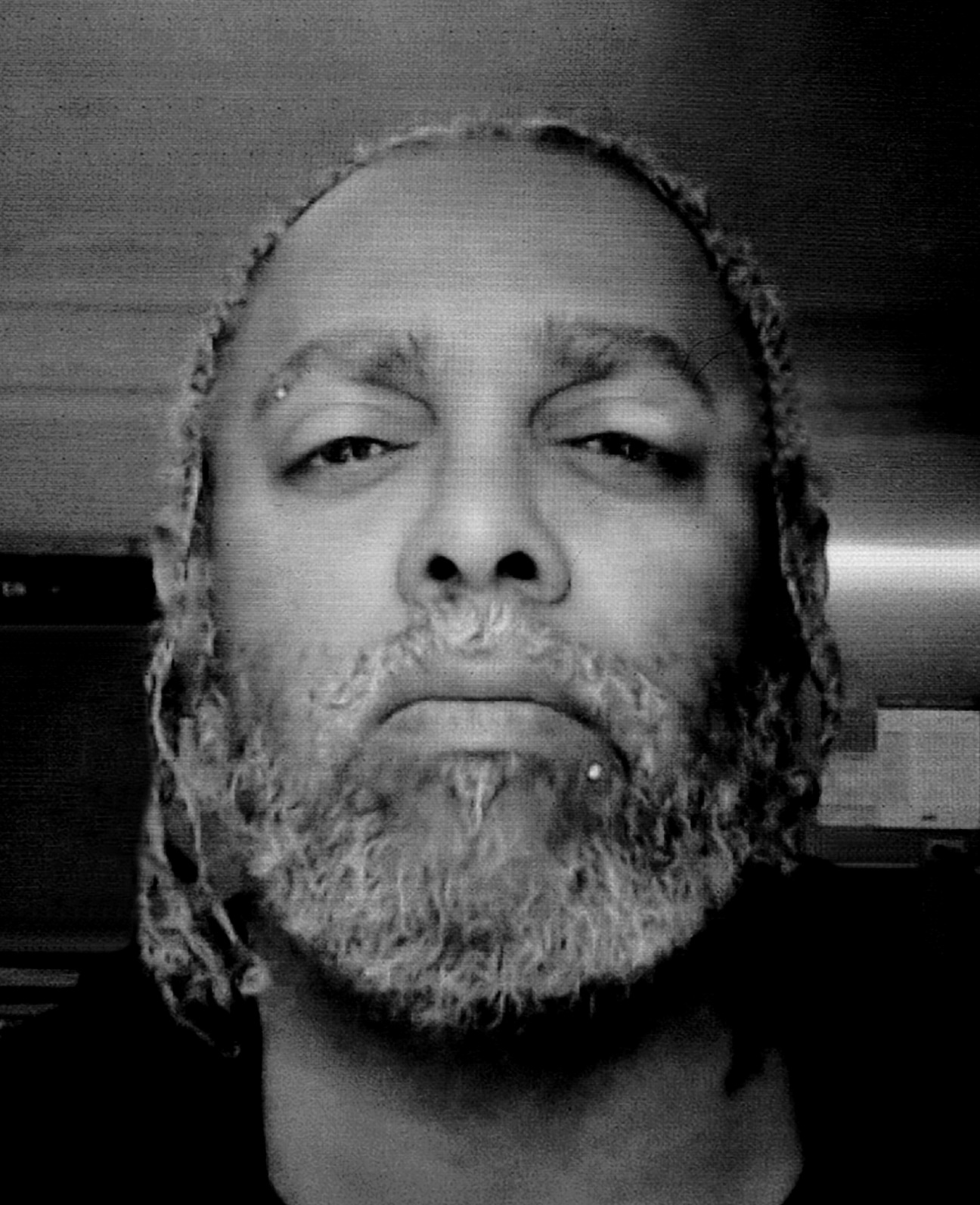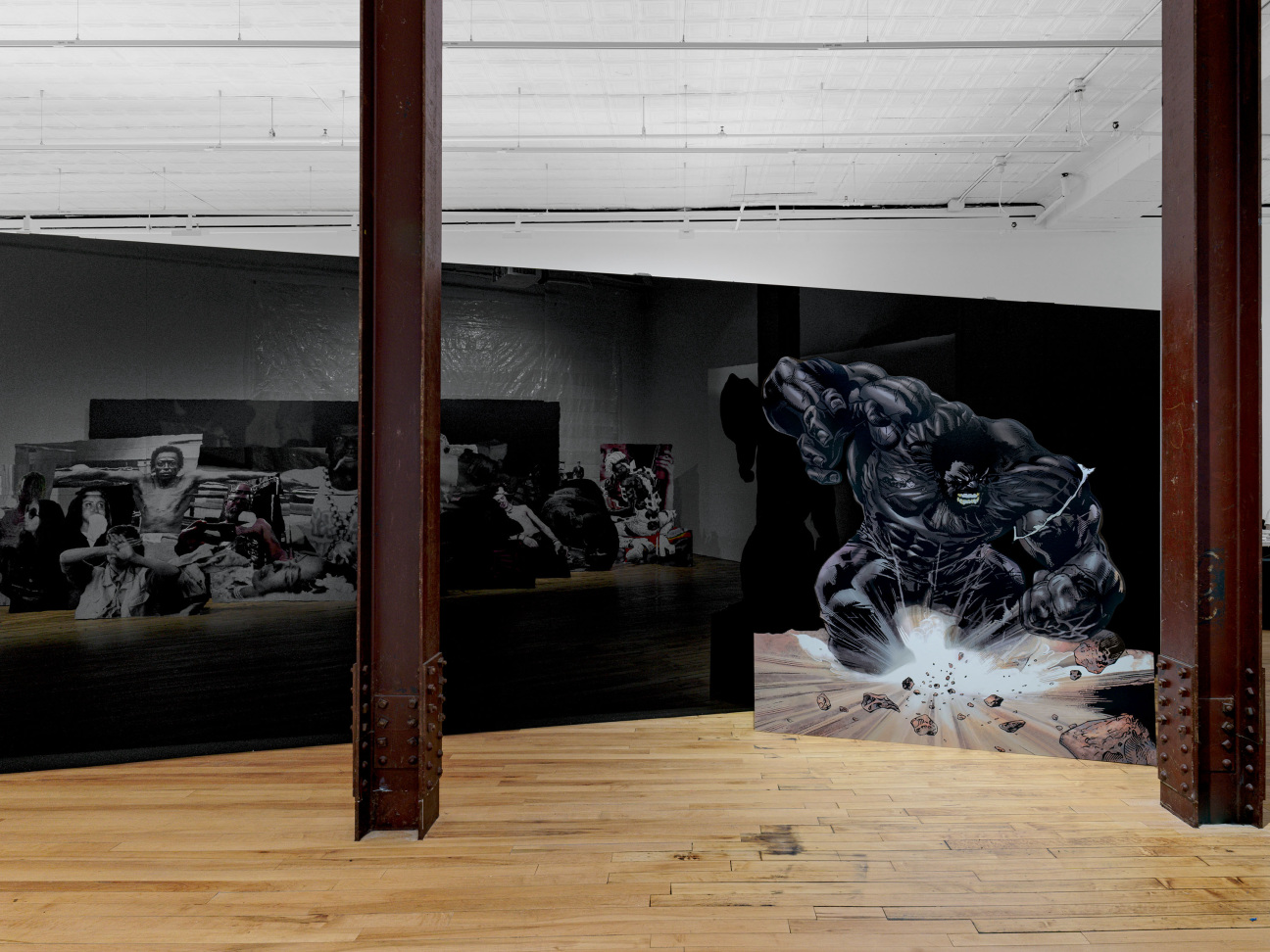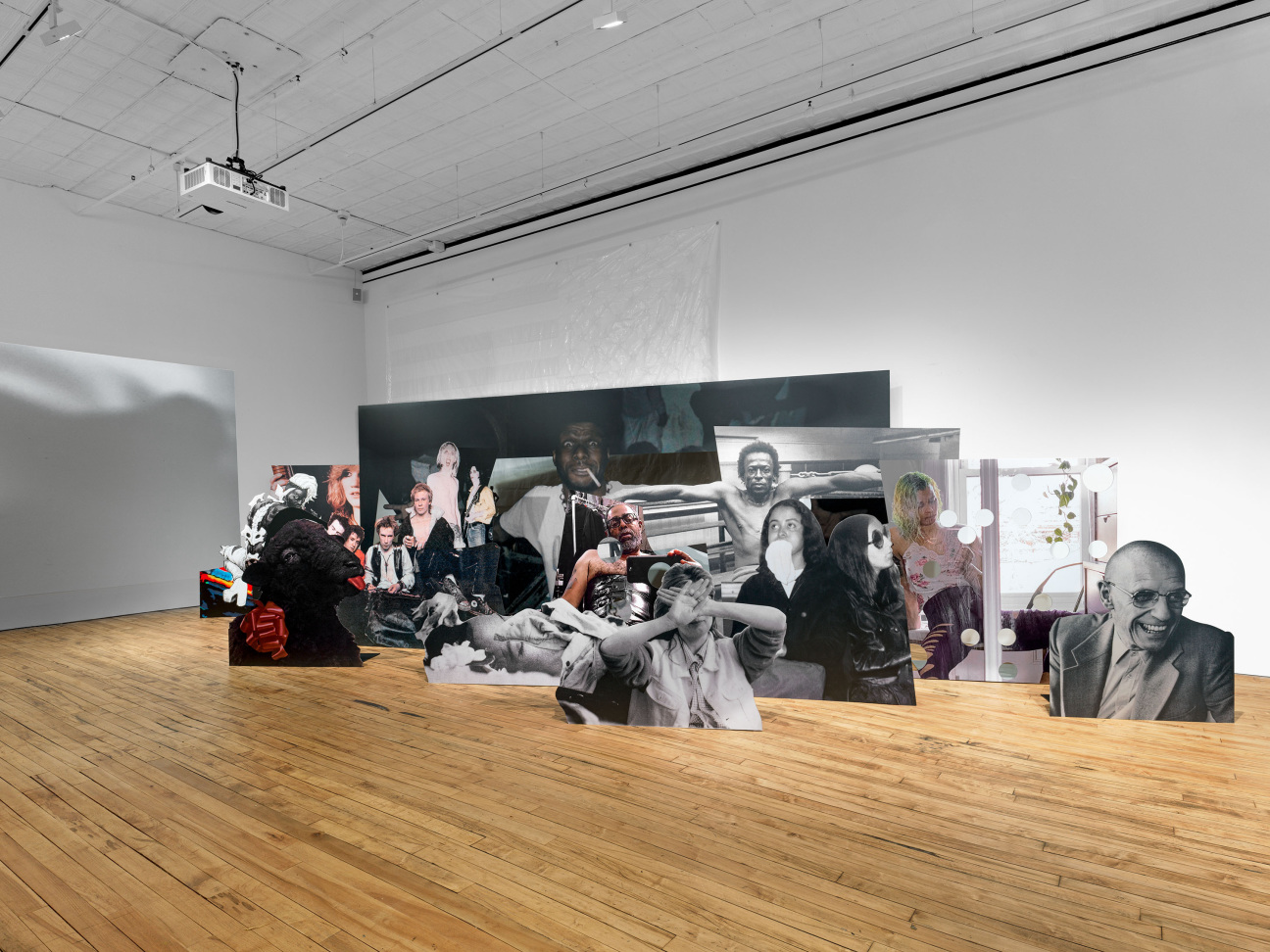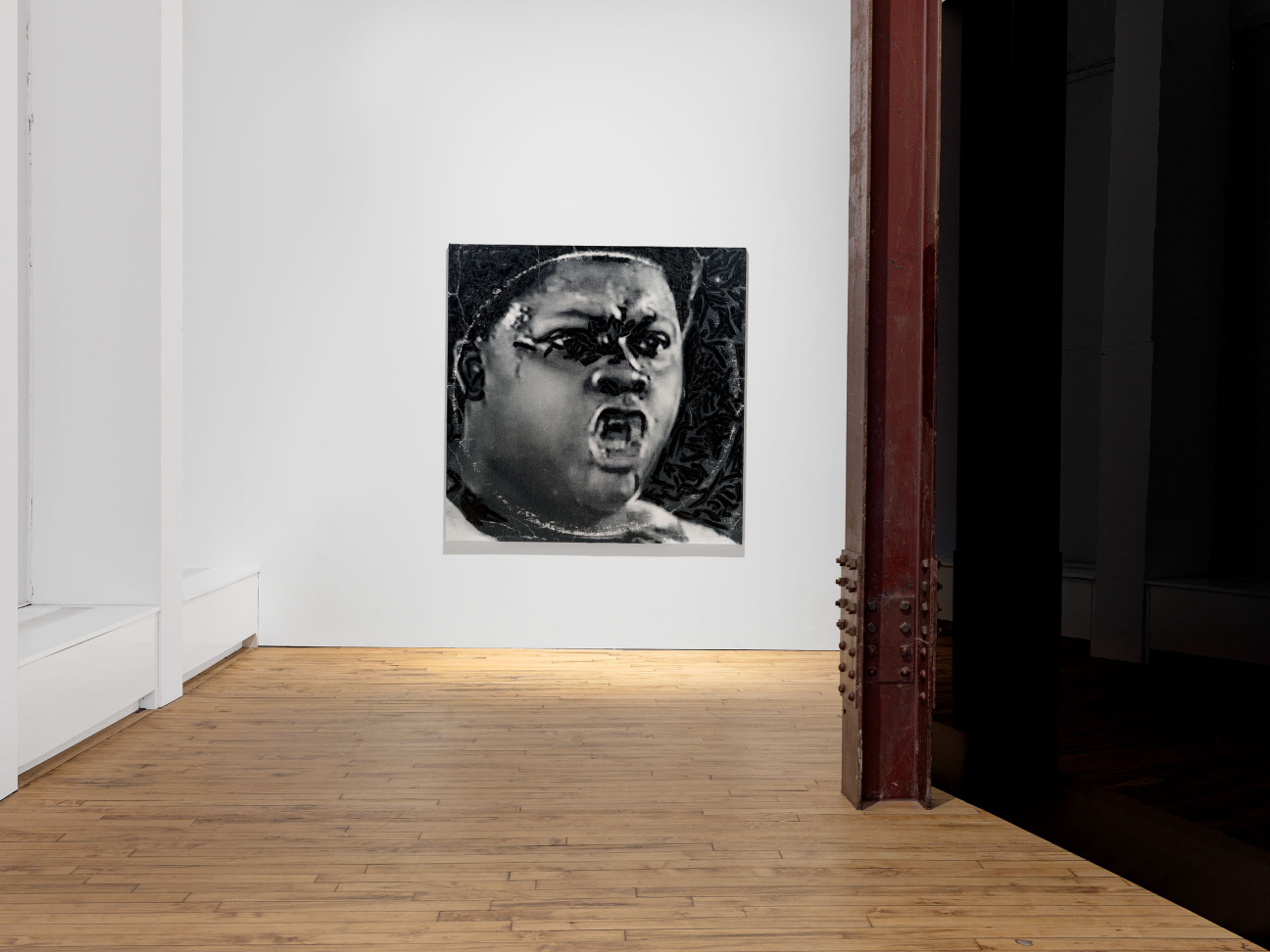
Upon walking into Arthur Jafa’s new exhibition at 52 Walker, titled (and intentionally misspelled) “BLACK POWER TOOL AND DIE TRYNIG,” one sees Summer Dark, 2024, a diptych of two heavily made-up pinups gazing solicitously into the camera. Initially, it looks like the stuff of nudie magazines until you realize both images bear scarification. On the right, the singer Summer Walker dons a blue lace bikini that barely conceals a fresh gash from breast implants; on the left, the novelist Akwaeke Emezi is pictured after a gender-affirming mastectomy with twin keloid scars. Beneath is a tattoo that reads “dead thing.” Themes of the lifecycle permeate the exhibition. In one work, No Mountain High, 2024, black acrylic shapes are placed across black canvas. Are they labia, or are they skulls?
At the heart of the show is a giant box. Picture Unit (Structures) II, 2024, is a formidable (60-foot long and nearly 12-foot tall) windowless rectangle with a slick black exterior. It is Kubrick’s monolith; it’s Kaaba; it’s Serra, black site, and sarcophagus. Inside are a dozen or so fuzzy, blown-up photographs that progressively evoke a house of horrors. In part, it is a tribute to outlaw cultures and forbidden practices and full of easter eggs of cultural figures who have influenced the artist. There are bikers from the East Bay Dragons motorcycle club and Richard Prince’s appropriated Untitled (Girlfriend), 1993, wearing a skull and bones. We see a fairly recent scene from Atlanta’s famous Magic City strip club and a vintage subway train painted by the legendary graffiti artist Cano.

For two decades, artists have used the absolute glut of images available online to make often erratic works about the nonsequitur quality of the Internet itself. Jafa is doing something else here. His project adopts this practice of endless trawling to create something that feels distinctly old-fashioned. The exhibition feels like living inside a mimeographed zine or a snuff film; it lies somewhere between the photomontage of The Black Book, 1974, and the 1978 snuff film Faces of Death. By combing the underground of his own psyche and ours, Jafa reveals a visual netherworld that was always right in front of us. Many of these images were once in circulation but have been shuttled out of view and deemed inappropriate for the public. My searches for some of these pictures brought me to dark and private corners of the Internet where pictures of violence are still passed around as samizdat.
The specter of the macabre is ever present. In the box, Bobby Hackney from the Detroit punk band Death is pictured wearing a shirt bearing the band’s name in sparkly, iron-on letters. There is Jafa’s own photograph of piles of soiled clothes at a memorial for the Rwandan genocide, and shockingly, a crime scene photo of the pregnant actress Sharon Tate covered in blood at the hands of the Manson family. Throughout the show, women are on the defensive, barricading doors and brandishing rifles, while eccentric Black male genius—especially in the presence of Miles Davis and Jafa’s beloved friend, the late critic and guitarist Greg Tate—is exalted. I can hear music playing, a sweet and mournful tune, but the spirit of the show is something between Sun Ra Arkestra and the metal genre called sludge.

After rounding the bend and exiting the box, you encounter an array of larger-than-life cut-out photographs mounted on steel in a kind of collage. You’ve seen these pictures before, but can’t place where. The themes of death pervade but so do ideas of failure. At left, we see a profile of Billie Holiday in her coffin; behind it is a 1964 photo of investigators examining the car of the murdered civil rights workers James Chaney, Michael Schwerner, and Andrew Goodman. Sid Vicious and the Sex Pistols are present, as is Miles Davis, here staring from the corner of a boxing ring, arms outstretched like a Christ. (Amid all this masculinist violence, it’s hard to forget the accounts of Davis hitting his wife.) A photograph of artist Adrian Piper and her popped bubble gum from her ‘60s performance Catalysis sits next to a grinning Michel Foucault and his gold-capped molars. In the center, Jafa, in bondage gear, takes a selfie as does elsewhere, the artist Tourmaline. And, at the very front of this eclectic arrangement appears an image from the cover of Funkadelic’s Greatest Hits, a prize-winning (literal) black sheep.
Like Picture Unit itself, this show is dark, but also slick. Jafa works through a language that is highly sui generis. After making films in the 1990s and showing small works in group shows at Jack Shainman in the early 2000s, Jafa’s breakout video Love is the Message; The Message is Death (2016), a mix of video footage sourced online, was received with mixed impressions. It was tragic, but it was also sentimental, and arguably commemorative in the mode of much work produced in the period of viral videos of police brutality. Jafa’s recent video titled *****, the subject of a concurrent exhibition at Gladstone Gallery, replaces the shooting victims at the end of Scorcese’s Taxi Driver with Black actors.

Paradoxically, Jafa’s projects that flirt with the concept of “Black social death,” a theory of people who are forever alienated by wider society, often highlight the popular image, the celebrity, and the viral over ordinary people. It occurred to me that perhaps “Black social death” is like surrealism 100 years ago—an approach to politics, sure, but also something akin to a lifestyle for a small group of cultural luminaries. It was hard to square the pessimistic idea of unshakable racial marginality as I pushed through the monied and well-heeled Black visitors queuing outside the exhibition’s opening—Black social death as Black social life.
Still, "BLACK POWER TOOL AND DIE TRYNIG," among Jafa’s other works, feels like an end to the sometimes repetitive project of building positive Black representation. For this, I am relieved. It is as though these disturbing and glitchy visions are the archival underside of all of the uplifting and ameliorating exhibitions of Black art on view in New York right now—of the Harlem Renaissance at the Metropolitan Museum of Art, the videos in the Whitney Biennial, and especially the collection of Alicia Keys and Swizz Beatz at Brooklyn Museum (where Jafa’s sculpture is one of the show’s only non-figurative works). For a change, a show on Black subjects that can’t be described through the lens of beauty. If those shows are the ego, here lies the id.
"BLACK POWER TOOL AND DIE TRYNIG" is on view through June 1, 2024 at 52 Walker in New York.










 in your life?
in your life?

